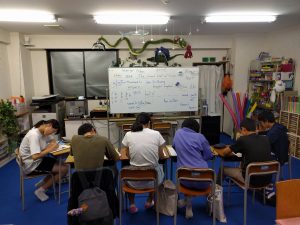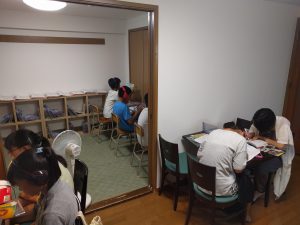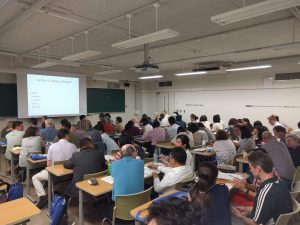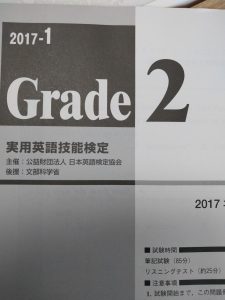Academy curriculum extensive reading goals high school junior high school language courses school management
by sendaiben
4 comments
Cambridge Academy: Year Three Student Progress
Encouraging developments

Second-year junior high school students in the output class
You can read previous Academy posts here:
- Extensive Reading for Secondary Students (April 2015)
- Six Months In (September 2015)
- Year One (February 2016)
- Looking at Year Two (March 2016)
- Stocktake (March 2016)
- Shadoku explained (April 2016)
- Some improvements to the curriculum (April 2016)
- December 2016 update (December 2016)
- Cambridge Academy: Year Two and Three (March 2017)
- Cambridge Academy: Stocktake 2017 (March 2017)
- Cambridge Academy: Another Quantum Leap (April 2017)
- Cambridge Academy: Year Three Mid-Year Update (August 2017)
The Academy is still going well. I’m having a lot of fun and I think at least some of the students are enjoying it too 😉
We lost one more student on average (lost three, gained two), but I think this is normal and it isn’t something that worries me. The students who are leaving tend to be our older students who started before the Academy existed and haven’t benefited as much as our newer students will from improved lessons and system. Here are our latest numbers:
Right now we have 78 students:
- 32 junior high school first years (29 regular, 2 reading only, 1 advanced)
- 21 junior high school second years (15 regular, 4 reading only, 2 advanced)
- 8 junior high school third years (5 regular, 3 reading only)
- 7 senior high school first years (4 regular, 3 reading only)
- 6 senior high school second years (5 regular, 1 reading only)
- 2 senior high school third years (2 regular)
- 2 ronin students (1 regular, 1 reading only)
It looks like we’re going to fill our first year output classes, as one student has changed to output after a few months of tutoring, and a trial student last week is going to try to do the same.
Today I’m going to share the students’ reading numbers. This gives some idea of how much our students are reading given an hour in class (probably more like 50-55 minutes) and for a few of them also reading at home. All numbers are up to date as of today.
First year (six months or so): 16,885-111,509 (most students are in the 30,000-50,000 range), YL0.2-0.4
Second year (eighteen months or so): 75,850-354,976 (most students are in the 120,000-160,000 range), YL0.3-0.6
Third year (thirty months or so): 197,892-748,564 (most students are around 300,000), YL0.6-4.0
You can’t really tell from the numbers above, but each year is reading more/better/faster than the years above them. Our current first years seem to be doing much better than our current second years did in their first year, who did better than our current third years did in their first year. I predict our current first years will be hitting 500,000 words by the end of junior high school, which should set them up to read a couple of million by the time they finish high school.
We need to continue buying intermediate books, and I am working on that. I am trying to find more leveled readers and books aimed at native speakers rather than graded readers (which tend to be a bit more dry). We already have mostly graded readers anyway. Students who find a series they like (Magic Tree House is very popular) and then read all the books in the series tend to do very well in terms of motivation and reading progress.
I have pretty much decided not to increase class sizes above ten, mostly due to the physical constraints of our current classrooms. I think we could do twelve easily, and probably up to twenty, but we just don’t have the room.
In terms of who will teach the classes, I am hoping to assign a teacher to each class next year. I will then join certain classes to model, observe, give feedback, etc. This should allow me to develop the system and get more of a birds’ eye view. Eventually it should allow me to take a step back with regards to the actual teaching too (and maybe open another school, but that’s a different blog post).
What do you think? What are your students’ numbers like? Any good intermediate books/series I could get?
Cambridge Academy: Year Three Mid-year Update
Incremental Change

Monday junior high school first-years
You can read previous Academy posts here:
- Extensive Reading for Secondary Students (April 2015)
- Six Months In (September 2015)
- Year One (February 2016)
- Looking at Year Two (March 2016)
- Stocktake (March 2016)
- Shadoku explained (April 2016)
- Some improvements to the curriculum (April 2016)
- December 2016 update (December 2016)
- Cambridge Academy: Year Two and Three (March 2017)
- Cambridge Academy: Stocktake 2017 (March 2017)
- Cambridge Academy: Another Quantum Leap (April 2017)
We’re almost halfway through year three of the Cambridge Academy. As I wrote about in the last update we’re trying out our new Fluency Course this year along with larger classes (up to ten students). I’m also teaching six nights a week.
Right now we have 79 students:
- 31 junior high school first years (28 regular, 2 reading only, 1 advanced)
- 21 junior high school second years (15 regular, 4 reading only, 2 advanced)
- 8 junior high school third years (5 regular, 3 reading only)
- 8 senior high school first years (5 regular, 3 reading only)
- 6 senior high school second years (4 regular, 2 reading only)
- 3 senior high school third years (2 regular, 1 reading only)
- 2 ronin students (2 regular)
So far, so good. The Fluency Course is going well with the first years, who are using it as their only materials. For the second and third years we have been using the first year timed reading texts alongside our original question cards and workbooks, as well as commercial textbooks.
From this month the third years have been trying our second year Fluency Course. Right now we only have the first month written, so we have to write each month in order for the students to use it the following month. I am writing the second month as we speak (well, actually I am procrastinating by writing this blog post instead!).
The junior high school students are streamed by school year (we have three first year, two second year, and one third year class), apart from advanced students who either get private classes or join a senior high school class. Senior high school students are streamed by level/ability, and we currently have three levels/classes.
We made another big book order for YL0.3 and 0.4 taking us to roughly ten copies of each set, and I think we’ll probably do the same for 0.5 and 0.6 later in the year.
The main developments have been in the input (reading) classes, and how we approach them now and in the future.
At this point it seems like our current first years are doing better than our first years last year. I can think of several reasons. We made student manuals to help explain the system. We modeled what we wanted to see in the reading classes, both at the beginning and several weeks in when we saw that some students were going off track. We introduced a read to the teacher extra step when students finish a set.
It seems likely that we should be able to aim for our students to reach intermediate level (YL1.1+) by the end of the third year of our course, having read over half a million words. If they then choose to stay with us during senior high school, we can try to get them to the lift-off stage where they go on to read 1-2 million words over the following three years.
However, we are still not achieving the results that some of the best ER programs in Japan boast. This month I attended the Extensive Reading World Congress and was able to attend some very inspiring presentations by Japan Extensive Reading Association members.
I learned two important things:
- The results reported by some programs seem to be outlier students chosen for effect and do not represent the average student. In the case of SEG, they have three levels of class (advanced, normal, and low-level). Due to their student demographics (large number of returnees and kids expecting to get into Tokyo University), our student population is closest to their low-level classes, and we are achieving similar results so I feel much better about our program now.
- With guided ER it is important not to increase student levels linearly, but instead to have them fluctuate up and down. This is expressed in the concepts of kirin (giraffe) reading, where students read above their baseline level, and panda reading, where they read below. Through judicious use of these two variations, we should be able to have our students progress slightly faster than they have done until now.
We have identified three types of student at our school, each of which requires slightly different treatment.
Fast students: can advance quickly, only reading a couple of books/sets at each level. Goals are to get to intermediate then find a series they enjoy in order to do narrow reading. I think our current approach is fine with these students, but we might be able to do better at introducing books/encouraging them to stretch themselves.
Normal students: can advance at a normal pace, reading about 2/3 of our readers at each level while also doing kirin reading and panda reading. Goals are to level up as quickly as possible without getting ahead of their understanding. I think we can help these students move quicker by judicious coaching.
Slow students: can advance only slowly, often requiring extra reading at each level before moving up. Kirin reading may help these students and is something we will investigate. Perhaps we could provide more support by reading with these students or helping them understand/interact with the texts.
Compared to SEG, we have about half the in-class reading time, and much more importantly a much less motivated and academically-gifted student body. Despite these restrictions, I am hopeful we’ll be able to help most of our students achieve meaningful progress in their English skills.
The obstacle is that even for SEG it seems to take 4-5 years before the effects really start to show. Getting students (and their parents) to persist until they reap the benefits of their effort seems to be the tricky part. We’re getting better at this, and are losing fewer students than we were in the first year.
Last year we almost filled our three classes of ten. It looks like we’ll have around thirty students coming up from elementary school classes, so should have similar numbers in April.
Things I need to figure out before next year:
- Do we increase our class limits to twelve? I think it would work pedagogically, and of course it would make the classes more profitable, but we’d really be stretching the physical limits of both our input and output classrooms. Right now ten is snug, so twelve might be too tight.
- Who is going to teach the classes? We could go in one of four directions: I keep teaching both input and output classes, alongside other teachers and our interns. I teach all the output classes, and leave the input classes to our interns. I leave the output classes to our teachers and teach all the input classes. I ask our teachers and interns to teach all the classes, and float, observing and helping as needed. I think it might be a bit soon for the last option.
Running the Academy is still one of the most fun and interesting things I have done as a teacher, and I am really looking forward to figuring out how to make the program even better over the next few years.
ERWC4: The Last Lecture
Went pretty well
I attended the Extensive Reading World Congress last week and gave my last presentation on teaching. Over sixty people were kind enough to attend the 2.5 hour workshop, and we had a very productive session.
The workshop was run PDR style, and we were able to cover four of the five topics I had prepared.
You can see the slides here, and the worksheets here. I think the content would be useful for someone thinking about starting or developing an ER program to work through.
Please feel free to post any questions or comments below.
conference extensive reading presentations school management teaching
by sendaiben
6 comments
The Last Lecture (well, workshop)
ER Program Design and Implementation
Extensive Reading World Congress, Toyo Gakuen, Tokyo
Friday August 4th, 15:30-18:00
At the beginning of next month I’ll be doing a pre-conference workshop at the Extensive Reading World Congress in Tokyo. This will be my last presentation on education.
The title is the same as the book I have been thinking about writing for the last few years. The content too. In a way, it’s the summary of the last ten years of my work as a teacher. I hope it comes together the way I would like it to. If it does it should be a pretty comprehensive introduction to all aspects of designing and running an extensive reading program at the institutional level.
It’s a workshop, so we’ll be doing work. I’m going to use the PDR (preparation, discussion, reaction) framework to structure the group discussions and will cover the following areas:
- Designing a Program
- Selling a Program
- Setting up a Program
- Running a Program
- Leaving a Program
If you come to the conference I hope you will consider spending a couple of hours with us on Friday. I can almost guarantee you will find it useful.
If you have any questions before the event feel free to post them in the comments below.
Changes to the STEP Eiken Tests (June 2017)
There have been a few…
The STEP Eiken Test is probably the best-known and most widely-recognized test of English for Japanese schoolchildren. It is closely tied to the school curriculum and the organization that produces it is trying to get more involved with university entrance tests once they are mandated to be 4-skills (from 2020).
Recently there have been quite a few changes to the STEP Eiken tests, most of which took me by surprise, so this post is to give other teachers a heads-up as to what has changed and what the latest version of the test looks like.
It seems as though the Eiken Foundation is trying to make the tests more rigorous in line with the new Course of Study and objectives for English education in Japan (particularly with regards to the upcoming changes to the university entrance tests).
I’ll describe each level in detail below, but the general changes are:
- the test seems to have gotten harder overall (the vocabulary and reading sections seem more difficult to me)
- there are new written sections in levels 3 and pre-2 (2, pre-1, and 1 already had a written section)
- there are new, optional, online “speaking” tests for levels 5 and 4
- the interview tests for levels 2, pre-2, and 3 are more rigorous: you now have to pass each section in order to pass the test. Merely getting a passing score is no longer enough to pass (we had a student fail with 20 points last time)
- interview examiners can no longer keep the interview cards and manuals, which is going to make practicing more difficult in the future 😉
Grade 5
The grade 5 test is 25 minutes for the paper and 22 for the listening. It consists of:
15 vocabulary questions (choose the word that goes in the blank)
5 conversation questions (choose the phrase that goes in the blank)
5 ‘rearrange the sentence’ questions (put the words in order)
10 listening questions with reference pictures
5 listening questions where you choose a written answer
10 listening questions where you answer about a picture
Overall I think the test seemed similar to previous years. No huge changes.
Grade 4
The grade 4 test is 35 minutes for the paper test, and 28 for the listening. It consists of:
15 vocabulary questions (choose the word that goes in the blank)
5 conversation questions (choose the phrase that goes in the blank)
5 ‘rearrange the sentence’ questions (put the words in order)
10 questions based on reading passages (one easy, one medium, and one difficult)
10 listening questions with reference pictures
20 listening questions where you choose a written answer
The reading section seems to have gotten harder in this test. The final text was really hard.
Grade 3
The grade 3 test is 50 minutes for the paper test, and 25 for the listening. It consists of:
15 vocabulary questions (choose the word that goes in the blank)
5 conversation questions (choose the phrase that goes in the blank)
10 questions based on reading passages (one easy, one medium, and one difficult)
1 writing exercise where students have to write 25-35 words and answer a question giving two reasons. The question this time was: “Where do you want to go during your summer vacation?”. They seem to be using old questions from the level 3 speaking test for this section.
10 listening questions with reference pictures
20 listening questions where you choose a written answer
The reading section seems to have gotten harder in this test. The final text made me think. The new writing section is going to trip up students who haven’t done much writing or practiced for this section of the test.
Grade pre-2
The grade pre-2 test is 75 minutes for the paper test, and 25 for the listening. It consists of:
20 vocabulary questions (choose the word that goes in the blank)
5 conversation questions (choose the phrase that goes in the blank)
5 vocabulary and phrase questions (choose the words that go in the blank in longer passages)
7 questions based on reading passages (one easy, one medium, and one difficult)
1 writing question where they examinees have to write 50-60 words and answer a question giving two reasons. This time the question was: “Do you think it is better for people to eat in restaurants or at home?”.
10 listening questions with no visual reference
20 listening questions where you choose a written answer
Overall this test felt slightly harder. Again, the writing question is similar to past interview questions for grade pre-2. The pre-2 test feels too long now. I think they have given too much extra time for the writing section.
Grade 2
The grade 2 test is 85 minutes for the paper test, and 25 for the listening. It consists of:
20 vocabulary questions (choose the word or phrase that goes in the blank)
6 vocabulary and phrase questions (choose the words that go in the blank in longer passages)
12 questions based on reading passages (one easy, one medium, and one difficult)
1 writing question where they examinees have to write 80-100 words and answer a question giving two reasons. This time the question was: “Today, more and more young people are starting their own companies. Do you think this is a good idea?”
30 listening questions where you choose a written answer
Overall this test felt slightly harder. Again, the writing question is similar to past interview questions for grade 2. This test also feels a bit too long.
I haven’t seen the new grade pre-1 or 1 tests yet, but I presume they haven’t changed as much. You can see past papers and a lot more information at the STEP Eiken website.
Anything to add? How are you finding the new tests?


